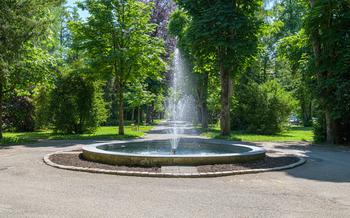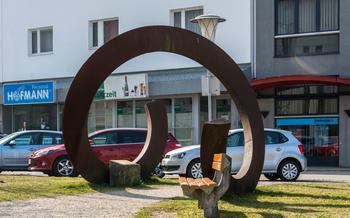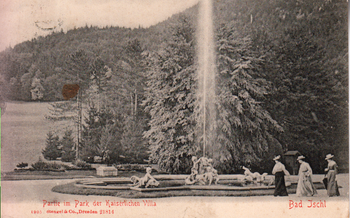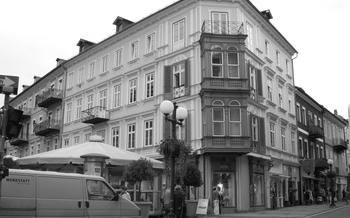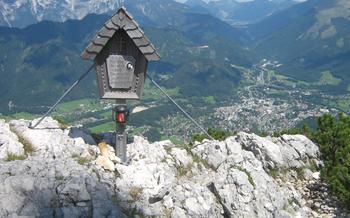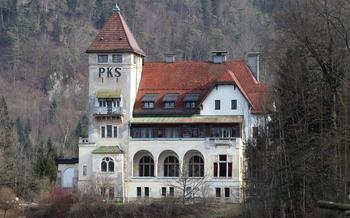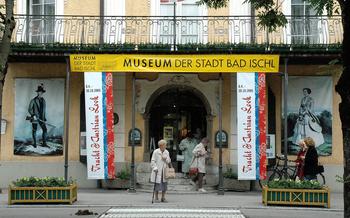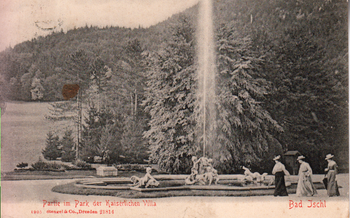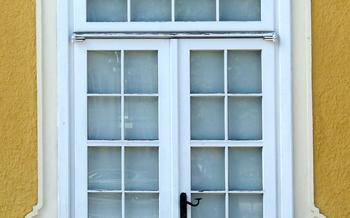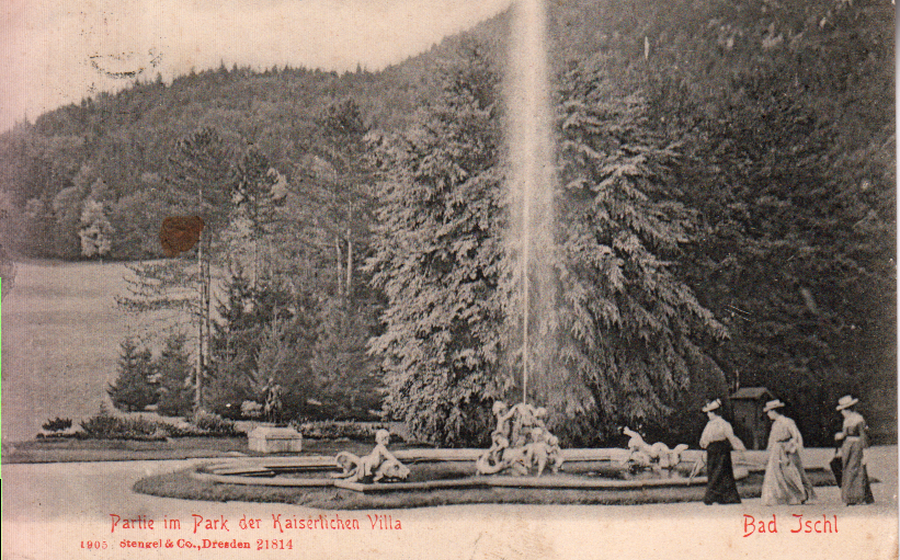
Kaiservilla in Bad Ischl
- History of the Kaiservilla in Bad Ischl
- Architecture and Design of the Kaiservilla
- Visiting the Kaiservilla
- Exhibitions and Events at the Kaiservilla
- The Kaiservilla and Tourism
- The Kaiservilla in Popular Culture
- The Kaiservilla and the Imperial Family
- The Kaiservilla During World War I
- The Kaiservilla After the Monarchy
- The Kaiservilla Today
- Local Cuisine and Specialties
- Nearby Attractions and Activities
- Photography Tips
- Insider Tip: Unveiling the Secret Imperial Garden
History of the Kaiservilla in Bad Ischl
Constructed in 1853, the Kaiservilla in Bad Ischl was initially conceived as a hunting lodge for Emperor Franz Joseph I. However, it quickly transformed into a beloved summer retreat for the imperial family, serving as their primary residence during the warm months. Empress Elisabeth, in particular, held a deep fondness for the villa, finding solace and freedom within its idyllic surroundings.
The Kaiservilla played a pivotal role in Austrian history, hosting countless political meetings, diplomatic gatherings, and social events. It became a symbol of the Habsburg dynasty's power and influence, witnessing significant decisions that shaped the course of the Austro-Hungarian Empire. Beyond its political significance, the villa offered the imperial family a sanctuary away from the constraints of court life, allowing them to indulge in leisure activities and spend quality time together.
Architecture and Design of the Kaiservilla
The Kaiservilla in Bad Ischl stands as a testament to the grandeur and opulence of the Austro-Hungarian Empire. Constructed in the Neoclassical style, the villa boasts a harmonious blend of Italian Renaissance and French Baroque influences. Its facade is adorned with intricate details, including pilasters, cornices, and decorative window surrounds that add depth and character to the building's exterior.
The interior of the Kaiservilla is equally impressive, showcasing a fusion of opulence and functionality. The imperial apartments, located on the first floor, feature grand reception rooms, private chambers, and lavishly decorated guest suites. Each room is adorned with exquisite furnishings, ornate chandeliers, and hand-painted murals that reflect the personal tastes and preferences of Emperor Franz Joseph I and Empress Elisabeth.
The villa's gardens and the surrounding landscape are integral to its overall design. The meticulously manicured gardens feature a variety of flower beds, sculptures, and fountains, creating a vibrant and picturesque setting. The gardens seamlessly blend into the surrounding landscape, offering panoramic views of the Traunstein mountain and the idyllic countryside beyond.
Over the years, the Kaiservilla has undergone meticulous restoration and preservation efforts to maintain its historical integrity. These efforts have included the restoration of original furnishings, the repair of structural damage, and the sensitive integration of modern amenities to enhance the visitor experience without compromising the villa's historical charm.
Visiting the Kaiservilla
The Kaiservilla is open to the public for guided tours, offering a glimpse into the opulent lifestyle of the imperial family. Tours are available in several languages, and visitors can choose from various options depending on their interests and time constraints. The standard tour covers the highlights of the villa, including the imperial apartments, reception rooms, and the beautiful gardens. For those seeking a more in-depth experience, specialized tours focus on specific aspects of the villa's history, architecture, or imperial life.
During your visit, be sure to take note of the villa's impressive architecture and interior design. Admire the intricate carvings, opulent chandeliers, and well-preserved furnishings that adorn the rooms. The gardens, with their meticulously landscaped lawns, colorful flowerbeds, and serene fountains, offer a peaceful retreat and a chance to soak in the natural beauty of the surroundings.
To make the most of your visit, consider booking your tour in advance, especially during peak tourist season. Also, remember to wear comfortable shoes as the tour involves a fair amount of walking. For a unique experience, plan your visit to coincide with one of the villa's special events, such as concerts, exhibitions, or historical reenactments, which offer a deeper dive into the villa's rich history and cultural significance.
Exhibitions and Events at the Kaiservilla
The Kaiservilla is not just a historical landmark but also a vibrant cultural venue that hosts a variety of exhibitions and events throughout the year. These events play a crucial role in promoting the villa's cultural heritage and engaging with the public.
Temporary exhibitions at the Kaiservilla showcase diverse themes related to the imperial family, Austrian history, and the cultural significance of the villa. These exhibitions often feature rare artifacts, documents, and personal belongings that shed light on the lives of the Habsburgs and their era.
In addition to exhibitions, the Kaiservilla also hosts concerts, lectures, and other cultural events. These events provide a platform for local and international artists to showcase their talents and connect with audiences in a unique historical setting. Concerts in the villa's grand ballroom or performances in the beautiful gardens offer a truly immersive experience.
To find out about upcoming events and book tickets, visitors can check the Kaiservilla's official website or contact the visitor information center in Bad Ischl. I had the privilege of attending a classical music concert in the villa's ballroom, and the atmosphere was simply magical. The acoustics were perfect, and it felt like I was transported back in time as the music filled the room.
The Kaiservilla's events offer a wonderful opportunity to delve deeper into the history and culture of the region. Whether you're interested in art, music, or history, there's something for everyone at the Kaiservilla. Be sure to check the event calendar before your visit to plan your trip accordingly and make the most of your time at this remarkable cultural destination.
The Kaiservilla and Tourism
The Kaiservilla is a significant tourist attraction in Bad Ischl and the Salzkammergut region. Its historical allure, architectural beauty, and connection to the imperial family draw visitors from around the world. Tourism related to the villa has a profound impact on the local economy, creating jobs, boosting revenue, and supporting related businesses such as hotels, restaurants, and tour operators.
The Kaiservilla contributes to the region's cultural heritage by preserving and showcasing a significant piece of Austrian history. Visitors can learn about the lives of Emperor Franz Joseph I and Empress Elisabeth and gain insights into the history of the Austro-Hungarian Empire. The villa's well-preserved interiors, artifacts, and exhibits offer a glimpse into a bygone era, making it a popular destination for history enthusiasts and culture seekers.
However, managing tourism at the Kaiservilla presents challenges in preserving its historical integrity and preventing overcrowding. Striking a balance between accessibility and conservation is crucial to ensure that the villa remains a sustainable tourist destination while maintaining its authenticity and charm.
One successful initiative in this regard is the implementation of guided tours with limited group sizes. This approach allows visitors to explore the villa's interiors while minimizing wear and tear and ensuring a personalized and informative experience. Additionally, the villa's management has implemented strict guidelines for preserving the historical integrity of the interiors, ensuring that the original furnishings, decorations, and artifacts are properly cared for and maintained.
By embracing sustainable tourism practices, the Kaiservilla can continue to attract visitors while preserving its historical significance and cultural heritage for future generations to appreciate.
The Kaiservilla in Popular Culture
The Kaiservilla has been featured in numerous works of popular culture, including films, literature, and television shows. This exposure has helped to raise awareness of the villa's historical significance and beauty, attracting visitors from around the world.
One of the most notable portrayals of the Kaiservilla is in the 1955 film Sissi, which tells the story of Empress Elisabeth of Austria. The film features several scenes shot on location at the villa, capturing its opulent interiors and stunning gardens. Sissi was a huge success, and it helped to popularize the Kaiservilla as a tourist destination.
The villa has also been featured in several other films, including The Great Waltz (1938), The Last Waltz (1953), and Mayerling (1968). These films have helped to bring the story of the Kaiservilla and the imperial family to a wider audience.
In addition to film, the Kaiservilla has also been featured in literature. For example, the villa is mentioned in the novel The Sound of Music by Maria von Trapp. The novel tells the story of the von Trapp family, who lived in Salzburg during the Nazi era. In the novel, the von Trapp children visit the Kaiservilla and are impressed by its grandeur.
The Kaiservilla's popularity in popular culture has helped to make it one of the most recognizable landmarks in Austria. The villa's unique architecture, beautiful gardens, and historical significance have made it a popular destination for tourists and filmmakers alike.
The Kaiservilla and the Imperial Family
The Kaiservilla holds a profound significance in the history of the Habsburg dynasty. It was a beloved summer retreat for Emperor Franz Joseph I and Empress Elisabeth of Austria, who spent many happy moments within its walls. The imperial couple cherished their time at the villa, away from the formal constraints of court life.
Empress Elisabeth, in particular, found solace and freedom at the Kaiservilla. She enjoyed the opportunity to pursue her passions, such as painting and horseback riding, in the idyllic surroundings of Bad Ischl. The villa provided a private haven where the imperial family could relax and rejuvenate, surrounded by the beauty of nature.
Stories abound about the imperial family's time at the Kaiservilla. One anecdote recalls a mischievous incident involving Empress Elisabeth's beloved dogs. The empress allowed her dogs to roam freely throughout the villa, and on one occasion, they playfully knocked over a valuable porcelain vase. Rather than reprimanding the dogs, Empress Elisabeth laughed heartily and declared that the broken vase was a small price to pay for their happiness.
Such anecdotes provide a glimpse into the personal lives and relationships of the imperial family. The Kaiservilla was not merely a summer residence but a place where they created lasting memories and cherished moments together.
The Kaiservilla During World War I
During the tumultuous years of World War I, the Kaiservilla became the wartime headquarters for Emperor Franz Joseph I. The villa served as a sanctuary for the imperial family, providing a temporary respite from the turmoil and devastation that engulfed the empire. Despite the challenges and difficulties they faced, the imperial family and staff demonstrated remarkable resilience and compassion during this trying period.
One poignant story from this time is that of the emperor's daily walks through the villa's gardens. Accompanied by his loyal dog, he would often pause to chat with wounded soldiers recuperating in the nearby military hospital. His presence brought comfort and encouragement to these young men, who were touched by his genuine concern and kindness.
Another remarkable tale is that of the imperial family's decision to turn the villa into a makeshift hospital during the war. With the influx of wounded soldiers, the villa's grand reception rooms and guest chambers were transformed into makeshift wards. Empress Elisabeth personally oversaw the care of the wounded, working tirelessly alongside nurses and doctors to provide comfort and relief to those in need.
Despite the hardships of war, the Kaiservilla remained a symbol of hope and resilience for the imperial family and the people of Austria. It stood as a reminder of the strength and unity of the nation, even in the darkest of times.
The Kaiservilla After the Monarchy
With the collapse of the Austro-Hungarian Empire in 1918, the Kaiservilla faced an uncertain future. The imperial family was forced to abdicate, and the villa was confiscated by the newly formed Austrian Republic. For a time, the villa was used as a military hospital, and later as a school.
In 1921, the villa was finally opened to the public as a museum. This decision was met with mixed reactions from the local population, who were divided on whether to preserve the villa as a reminder of the monarchy or to move on from the past. However, the museum proved to be a success, and it has remained open ever since.
Preserving the Kaiservilla's historical integrity while adapting it to new purposes has been a challenge. The museum has undergone several renovations and expansions over the years, and it now includes a modern exhibition center and a cafe. Despite these changes, the villa's original character has been preserved, and it remains a popular destination for visitors from all over the world.
One of the most significant challenges facing the Kaiservilla in the post-monarchy era has been the need to balance its historical significance with its role as a modern museum and cultural center. The museum has worked hard to maintain the villa's authenticity while also making it accessible and engaging for visitors of all ages.
Another challenge has been the need to address the villa's connection to the Habsburg monarchy. The Habsburgs were a controversial dynasty, and their legacy is still debated in Austria today. The museum has taken a balanced approach to this issue, presenting information about the imperial family without glorifying them or ignoring their flaws.
Despite these challenges, the Kaiservilla has successfully transitioned from an imperial residence to a modern museum and cultural center. It is a testament to the villa's enduring significance that it continues to attract visitors from all over the world, who come to learn about its history and to experience its unique atmosphere.
The Kaiservilla Today
The Kaiservilla stands as a testament to the grandeur of the past and the enduring legacy of the imperial era in Austria. Today, the villa has been meticulously restored and transformed into a museum, inviting visitors to step back in time and immerse themselves in the lives of Emperor Franz Joseph I and Empress Elisabeth.
As you wander through the villa's opulent rooms, you'll be transported to a bygone era of elegance and sophistication. Admire the beautifully preserved furniture, intricate tapestries, and stunning works of art that adorn the walls. Each room tells a story of the imperial family's daily lives, from formal receptions and lavish banquets to intimate family gatherings.
In addition to its historical significance, the Kaiservilla also serves as a vibrant cultural venue. Throughout the year, the villa hosts a variety of exhibitions, concerts, and events that celebrate the region's rich cultural heritage. These events breathe new life into the historic walls, attracting visitors from all over the world.
The Kaiservilla is not just a museum; it's a living, breathing testament to the past that continues to captivate and inspire visitors to this day. Whether you're a history buff, an architecture enthusiast, or simply someone who appreciates beauty and grandeur, a visit to the Kaiservilla is an unforgettable experience that will leave you with a lasting impression.
Local Cuisine and Specialties
A visit to Bad Ischl and the Kaiservilla offers a chance to savor the region's culinary delights. Traditional Austrian cuisine, with its hearty flavors and fresh ingredients, is a must-try. Indulge in classics like Wiener Schnitzel, a crispy, breaded cutlet served with potato salad and lingonberry jam. Sample Kaiserschmarrn, a fluffy shredded pancake often served with powdered sugar and fruit compote. For a taste of local specialties, try Knödel, dumplings made with bread, potatoes, or other ingredients, often served with gravy or sauerkraut. Don't miss the chance to taste Salzburger Nockerl, a sweet soufflé-like dessert served with powdered sugar and lingonberry sauce.
Along with these culinary delights, Bad Ischl is home to several charming restaurants and cafes. For a cozy ambiance and traditional Austrian fare, try Gasthof zum Goldenen Schiff, located in the heart of the town. Konditorei Zauner, a historic café known for its delicious pastries and cakes, is a must-visit for those with a sweet tooth. For a modern take on Austrian cuisine, Restaurant Hubertus am See offers a delightful dining experience with stunning lake views.
The connection between local cuisine and the cultural heritage of Bad Ischl is evident in the use of fresh, regional ingredients. Many restaurants source their products from local farms and markets, ensuring the highest quality and flavors. Whether you're enjoying a hearty meal at a traditional Gasthof or indulging in sweet treats at a charming café, you'll be immersed in the rich culinary traditions of this charming town.
Nearby Attractions and Activities
A visit to the Kaiservilla can be easily combined with other attractions and activities in Bad Ischl and the surrounding region. For history buffs, the Ischl Museum offers insights into the town's rich past, while the Lehar Villa celebrates the life and work of the renowned operetta composer Franz Lehár. Nature enthusiasts can explore the Salzkammergut Mountains with its scenic hiking trails, crystal-clear lakes, and charming villages. A visit to the Hallstatt Salt Mine, a UNESCO World Heritage Site, provides a glimpse into the region's mining history. For a relaxing day out, take a leisurely boat ride on Lake Wolfgang or indulge in spa treatments at one of Bad Ischl's many thermal baths.
Personal Recommendation: Don't miss the opportunity to take the Kaiservilla Panorama Trail, a scenic hiking route that offers breathtaking views of the villa and the surrounding landscape. The trail starts right next to the villa and takes you through forests, meadows, and along the Traun River. Along the way, you'll encounter picturesque viewpoints and historical landmarks, making it a perfect way to combine nature and history in one unforgettable experience.
Photography Tips
Capturing the Essence of the Kaiservilla Through Stunning Photographs
The Kaiservilla's architectural grandeur and its picturesque setting amidst the Salzkammergut mountains offer a feast for the eyes. Whether you're an experienced photographer or a casual shutterbug, here are some tips to help you capture stunning photos of this imperial gem:
-
Embrace the Golden Hours: Plan your visit to the Kaiservilla during the golden hours of sunrise and sunset to take advantage of the soft, warm light that casts a magical glow on the villa and its surroundings.
-
Explore Different Perspectives: Don't limit yourself to frontal shots. Walk around the villa, find unique angles, and experiment with different perspectives to create dynamic compositions.
-
Focus on Details: The Kaiservilla is adorned with intricate architectural details, from the ornate balconies to the delicate moldings. Capture these details with close-up shots to convey the craftsmanship and artistry that went into the villa's construction.
-
Play with Reflections: Make use of the nearby ponds and fountains to create stunning reflections of the Kaiservilla. Experiment with different angles and lighting conditions to capture the villa's mirrored beauty.
-
Capture the Surrounding Landscape: The Kaiservilla is nestled amidst breathtaking mountain scenery. Step back and capture the villa within its natural context, highlighting the harmonious relationship between architecture and landscape.
Insider Tip: Unveiling the Secret Imperial Garden
Beyond the grand public spaces of the Kaiservilla lies a hidden gem reserved for the imperial family's private moments of tranquility: the Secret Imperial Garden. Tucked away amidst lush greenery, this secluded paradise offers a glimpse into the personal lives of Emperor Franz Joseph I and Empress Elisabeth.
Imagine strolling through the garden's winding paths, surrounded by fragrant roses, vibrant rhododendrons, and towering trees. Discover intimate corners, hidden fountains, and secluded benches where the imperial couple sought solace and communion with nature.
One particular spot that captures the essence of this private retreat is the charming Chinese Pavilion. Built in the Orientalist style, this exquisite structure served as a place of contemplation and relaxation for the imperial family. Step inside to admire its intricate carvings, colorful decorations, and serene atmosphere.
Visiting the Secret Imperial Garden is like stepping back in time, experiencing the private world of the imperial family. It's a unique opportunity to connect with their personal stories and gain a deeper understanding of their lives beyond the public eye.
To access this hidden gem, inquire at the Kaiservilla's information desk about guided tours that include a visit to the Secret Imperial Garden. Availability may be limited, so advance booking is recommended to secure your spot in this exclusive experience.
